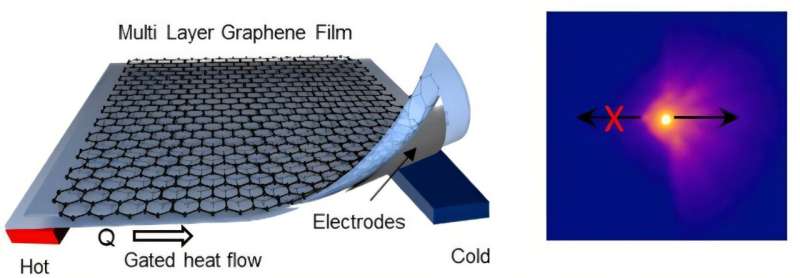Electric thermal switch designed for space uses graphite ion technology
An international team led by researchers at The University of Manchester’s National Graphene Institute has demonstrated a device capable of electrically controlling heat flow, potentially transforming thermal management in aerospace and advanced electronic applications.
The findings are detailed in Science Advances.
The team introduced a new type of thermal switch utilizing high thermal conductivity graphite films. When a voltage is applied, ions insert between graphite layers. These ions disrupt phonon motion, cutting thermal conductivity by up to 1,300%. Removing the voltage expels the ions and restores the original heat-carrying capacity.
This powerful modulation allows the device to actively turn heat conduction “on” and “off” at will, mirroring the functionality of electronic transistors, but for heat instead of electricity.
“This discovery represents a significant advancement in thermal management technology. For the first time, we’ve demonstrated a practical electrothermal device that provides precise and reversible control overheat transport,” said senior author Professor Coskun Kocabas.
“What makes our device truly transformative is its ability to operate reliably in extreme environments such as space,” said Dr. Pietro Steiner, lead author and current technology lead for graphene-based thermal technologies at SmartIR Ltd., a spinout from the University of Manchester.
“The solid-state nature and absence of mechanical parts make it particularly attractive for aerospace applications, where reliability, weight, and efficiency are critical.”
Beyond basic switching, the team demonstrated that their device could actively steer heat flow in desired directions. By configuring voltages across patterned electrodes, they created anisotropic thermal conduction pathways, opening possibilities for programmable thermal management systems.
Kocabas added, “This thermal switching technology could revolutionize spacecraft thermal regulation, offering dynamic and reconfigurable solutions to manage excess heat without complex moving mechanisms or bulky radiators.”
Spacecraft often rely on radiators or mechanical valves to dump excess heat. These systems add weight and risk mechanical failure under vibration. A thin, solid-state switch removes those constraints. It can operate in ultra-high vacuum and tolerate radiation levels found in orbit.
Next, the group will test switching speed under high thermal load. They plan to integrate the switch with prototype electronics. Faster ion motion and alternative intercalants could boost performance further.
By directly linking electrical signals to heat transport, this work lays the groundwork for programmable thermal management in aerospace, electronics cooling and adaptive insulation.
More information:
Pietro Steiner et al, Electrically controlled heat transport in graphite films via reversible ionic liquid intercalation, Science Advances (2025). DOI: 10.1126/sciadv.adw8588
University of Manchester
Citation:
Electric thermal switch designed for space uses graphite ion technology (2025, July 29)
retrieved 30 July 2025
from https://techxplore.com/news/2025-07-electric-thermal-space-graphite-ion.html
This document is subject to copyright. Apart from any fair dealing for the purpose of private study or research, no
part may be reproduced without the written permission. The content is provided for information purposes only.

Comments are closed